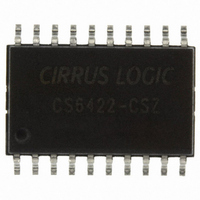CS6422-CSZ Cirrus Logic Inc, CS6422-CSZ Datasheet - Page 46

CS6422-CSZ
Manufacturer Part Number
CS6422-CSZ
Description
IC SPEAKERPHONE ENHANCED 20SOIC
Manufacturer
Cirrus Logic Inc
Type
Audio Processorr
Datasheet
1.CS6422-CSZ.pdf
(48 pages)
Specifications of CS6422-CSZ
Package / Case
20-SOIC
Applications
Speakerphones
Mounting Type
Surface Mount
Product
General Purpose Audio Amplifiers
Available Set Gain
34 dB
Thd Plus Noise
0.03 %
Operating Supply Voltage
5 V
Supply Current
10 mA, 50 mA
Maximum Operating Temperature
+ 70 C
Mounting Style
SMD/SMT
Audio - Load Impedance
10 KOhms
Input Offset Voltage
2.12 V
Minimum Operating Temperature
0 C
Supply Voltage (max)
5.5 V
Supply Voltage (min)
4.5 V
Rohs Compliant
Yes
Operating Temperature Range
0°C To +70°C
Digital Ic Case Style
SOIC
No. Of Pins
20
Lead Free Status / RoHS Status
Lead free / RoHS Compliant
Lead Free Status / RoHS Status
Lead free / RoHS Compliant, Lead free / RoHS Compliant
Other names
598-1200-5
Available stocks
Company
Part Number
Manufacturer
Quantity
Price
Company:
Part Number:
CS6422-CSZ
Manufacturer:
CIRRUS
Quantity:
61
Company:
Part Number:
CS6422-CSZ
Manufacturer:
CIRRUS
Quantity:
4
Part Number:
CS6422-CSZ
Manufacturer:
CIRRUS
Quantity:
20 000
Company:
Part Number:
CS6422-CSZR
Manufacturer:
CREE
Quantity:
210
Adaptive Filter
Echo Path
Path Change
AGC
Doubletalk
ERLE
Coverage Time
Convergence Time
46
46
A digital FIR filter that adjusts its coefficients to match a transfer function, such as the echo path
between the speaker and microphone. The adaptive filter is able to compensate for different and
changing conditions, such as someone moving in the room.
The acoustic echo path describes the acoustic coupling between the speaker and the microphone. It
describes both the magnitude and delay characteristics of the echoed signal. It is affected by the
speaker, microphone, phone housing, room, objects in the room, movement, and the talker.
network echo path is comprised of the transfer function between NO and NI.
A change in the transfer function that describes the Echo Path. Changes in the acoustic echo path are
most commonly due to motion in the room or gain changes at an external speaker. Network echo path
is most easily changed by picking up an extension or hanging up the phone.
The CS6422 implements a peak-limiting Automatic Gain Control to allow a greater dynamic range
without clipping the signal. See Section 4.1.3, “AGC” for details on how it works.
The condition occurring when both Near End and Far End talkers are speaking simultaneously.
Echo Return-Loss Enhancement is the amount of attenuation of echo signal an echo canceller provides
(not counting Suppression) as measured in dB.
performance. The larger the value for ERLE, the better the echo cancellation.
The CS6422 echo canceller has 508 taps and it can sample an analog signal at an 8 kHz rate.
512 x 1/8 kHz = 63.5 ms. Sound travels through air at a rate of around 1 ft/ms. Thus the echo canceller
can be used in a room with walls 32 feet away, discounting multiple reflections. But remember that at
this distance, most of the echo has been attenuated due to the physical separation. The majority of the
acoustic coupling comes from the first arrival, or directly from the speaker to the microphone. The first
signal is by far the strongest.
A high quality echo canceller is continuously modifying its internal model of the echo path characteristics
(See Section 4.1.1.2, “Adaptive Filter”). When the model is complete, the echo canceller will be able to
cancel echo to the extent of its rated capabilities. Convergence time is the duration it takes the echo
canceller to train itself, from cleared coefficients, and switch to full-duplex operation, in the presence of
speech.
ERLE is a measure of the echo canceller's
CS6422
CS6422
DS295F1
The















